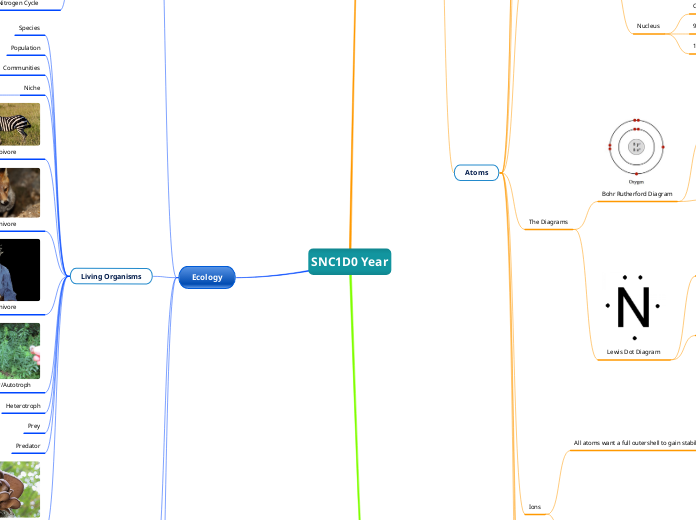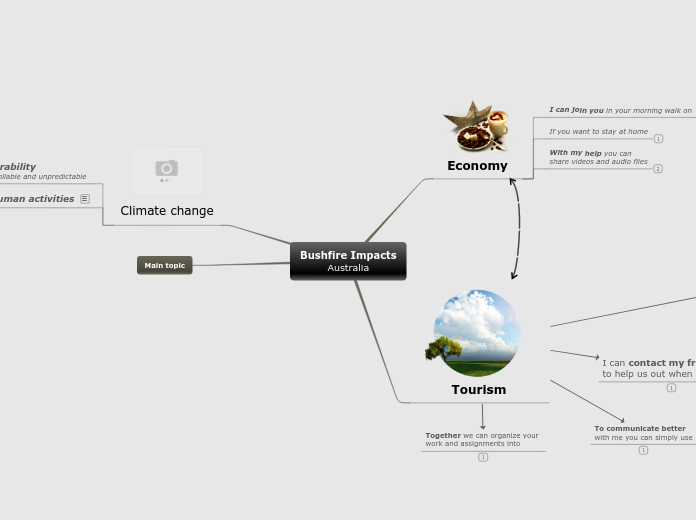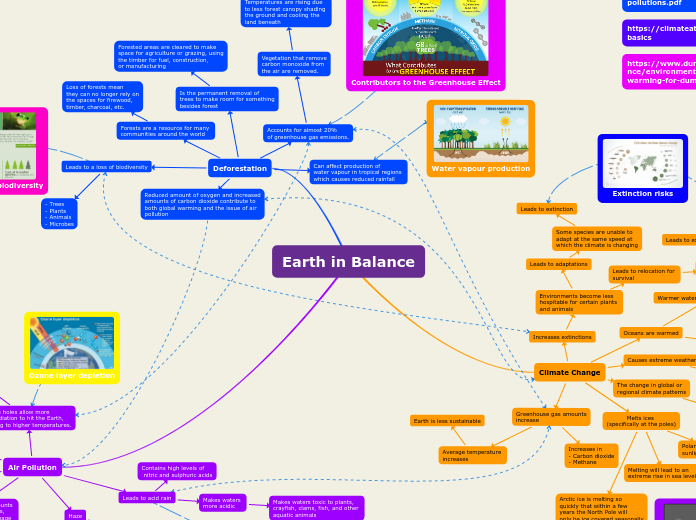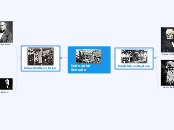SNC1D0 Year
Ecology
Energy Flow
Biogeochemical
Laws of Thermodynamics
Law of Conservation of Energy
Energy in the universe is constant and cannot be destroyed nor created and can only be transferred
Kinetic Energy
Actions
Chemical Energy
Cellular Respiration
Creates Co2, Water, Energy using Oxygen and Sugar
Light Energy
Photosynthesis
Creates Sugar, Food
Thermal Energy
Trophic Levels
Consumer
Food Web
Food Chain
Spheres of the Earth
Atmosphere
Hydrosphere
Lithosphere
Biosphere
Living Organisms
Decomposers/Detritivore
Predator
Prey
Heterotroph
Producer/Autotroph
Omnivore
Carnivore
Herbivore
Niche
Role of an organism in the environment
Communities
Population
Species
Environment
Nitrogen Cycle
Water Cycle
Carbon Cycle
Habitat
Biome
Ecosystem
Climate Change
Biotic Factors
Abiotic Factors
Electricity
Current Electricity
Electricity in Real Life Use
Formulas
Forumla for the Cost to Operate a Electrical System is: Cost = energy x Price (rate)
Formula for the Relationship between Power and Electrical Energy
Circuit Breakers
Circuit
Motor
Voltmeter
Measures Voltage
Ammeter
Measures Amps/Current
Ohm Meter
Measure Ohm/Resistance
Resisitor
Used to reduce current or control voltage
Switch/Control
Electric Load
Source
Electric Currents
Static Electricity
Charges
Electrostatic Series
Charge by Induction
Charge by Contact
Charge by Friction
Discharge
The Action of Removing a Charge
Grounding
Connecting a Charged Object to the Ground (The Earth is a Large Conductor that Spreads the Electrons
Conductors
Materials that Allow the Flow of Electrons from Atom to Atom
Insulators
Materials that Prevent the Movement of Electrons
Laws of Charges
Neutral Objects are Neutral to Each Other
Neutral Objects Attracts All Charges
Like Charges Repel Each Other
Opposites Charges Attract Each Other
Electrons
Can Move
Neutrons
Protons
Cannot Move
Chemistry
Atoms
Molecular Compounds
Naming Molecular Compounds
Chart to show the relationship between # of atoms and the prefixes
Always replace the ending of the 2nd symbol with -ide
Never add the prefix "mono-" to the first symbol
Since the nearly have full orbits, they share each others electrons that results in a Covalent Bond
A pure substance formed by mixing 2 or more non-metals
Metals that formed by metaling 2 metals together
Counting atoms
If there is a coefficient in front of everything, it represents the amount of that element/compound
The coefficient is multiplied with all subscripts within the formula
The subscripts of a atom represents the amount of the atom there is.
Subscripts outside brackets multiply all subscripts within the brackets before it
Ex: Cl 2 = 2 Chlorine atoms
Ions
Ionic Compounds
Steps to making the formula
The first symbol is always the metal followed up by the non-metal
Write the ionic charge above and to the right of the symbol it is attached to
Criss cross the charge
Divide the charges to to largest common factor to find the lowest ratio
Ionic Charge are the charges that are gained or lost to other elements
Created when a metal and non-metal combine
Non-metals always gain electrons
Metal atoms always lose electrons
All atoms want a full outershell to gain stability (2 or 8)
Atoms lose or gain more electrons depending to how close they are at the moment to the next full shell
Atoms that lose electrons have a negative charge and are called cations
Atoms that gain electrons have a negative charge and are called anions
Called Stable Octet
Reason why group 1, which only has 1 valence electron, are the most reactive
The Diagrams
Lewis Dot Diagram
The dots surrounding the letter(s) are the valence electrons
A shortcut to finding the valence electrons is looking at the groups the element is in
Starting at 1 electron at group 1, keep increasing by 1 until you reach group 2, where it skips all to way to 3 electrons at group 13. Continue the pattern of 1 electron every group afterwards.
Dots are placed singly then placed in pairs in the order: N -> S -> E -> W
Only the electrons on the furthest shell from the middle are represented
The Letter(s) in the middle are the elements/compounds symbol
Bohr Rutherford Diagram
Labels
Circles around the middle circle represent the shells
Circle in the middle represents the nucleus
The n represents the neutrons in the atom
The p represents the protons in the atom
Dots represent the valence electrons
Valence electrons are electrons on the shell
Relationship between # of electrons every shell
Structure
Nucleus
1% of the Atoms Volume
99% of the Atoms Mass
Contains the Protons and Neutrons
Neutron
Have Mass
Neutral Charge
Electron
Negative Charge
Have almost no mass
Orbiting the Nucleus
Lies on the "shell"
Shell contains 1% of the Atoms Mass
Shell contains 99% of the Atoms Volume
Proton
Positive Charge
Has mass
Periodic Table
Atomic Mass
Represents the sum of Protons and Neutrons of the Element
Atomic Number
Represents the amount of Protons or Electrons
Standard Atomic Notation
Chemical Symbols
First letter is always a captial
Abbreviations of Elements Name
Columns/Families
Elements get more reactive the more you go down the columns
Noble Gasses
Group 18
Halogens
Group 17
Transition Metals
Group 3-12
Alkaline Earth Metal
Group 2
Alkali Metals
Group 1
Hydrogen
Rows/Periods
Matter
Density
Formula
Amount of matter per unit of volume
Measured in g/mL or g/cm^3
Volume
Amount of space an object takes up
Mass
Amount of matter an object takes up
Physical and Chemical Changes
Chemical Changes
A change that results in a formation of a new substance
Physical Change
The change in shape, form or state in a substance
Properties of Matter
Chemical
Describes the ability for a substance to change into another substance
Physical
Description of the substance
Mixtures
Alloys
Heteogenous
Mixture where you can see the different components
Homogenous
Mixture where the form is uniformed
Pure Substances
Only made up of 1 kind of particle
Compounds
Made up of 2 or more different elements in fixed proportions
Elements
Composed up of only 1 kind of atom
States of Matter
Changes in the State of Matter
Deposition
Gas to Solid
Sublimation
Solid to Gas
Condensation
Gas to Liquid
Evaporation
Liquid to Gas
Freezing
Liquid to Solid
Melting
Solid to Liquid
Plasma
Gas
Particles are very far apart from each other
Liquid
Particles are seperated and far from each other
Solid
Particles are close togther
Particle Theory
Particles are attracted to each other
Particles are always moving
Temperature affects the speed that particles move at
There is always space between particles
Different Substances are made up of Different Particles









